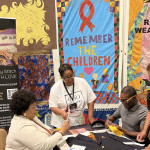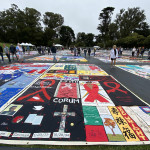The quilt that I began in my backyard nine years ago now covers 25 acres. It’s been nominated for the Nobel Peace Prize, and the film made about it, Common Threads: Stories from the Quilt, won an Oscar. It’s been featured in Doonesbury and on One Life to Live. Tens of thousands of people have participated in creating it and six million more have come to see it worldwide. Hivaphobe Reverend Fred Phelps calls it “that filthy fag blanket” and AIDS activist patriarch Larry Kramer wants it burned. It’s the world’s largest art project, and it’s still growing.
But I had no idea how far it would go that spring day in April ’87 when I spray-painted Marvin Feldman’s name on a 3-by-6-foot piece of cloth. I just knew that my best friend was dead and that I missed him terribly. And that the world was ignoring the disease that killed him.
Marvin would have hated that first panel I made in his name; its spray-painted casualness was not up to his standards at all. He would have wanted something fine enough to hang in the Museum of Modern Art or Suzie Tomkin’s collection at Esprit or at least the windows of Bloomingdale’s. Fortunately, Marvin had many friends -- all more talented than I -- and now he has many quilts. All but the first are beautiful.
When I started the Quilt I was searching for visible evidence of the horror that was then already so clear to me and to my friends -- trying to find a way to illustrate the enormity of the AIDS crisis to the rest of the world.
I remember standing at the corner of Castro and Market streets with my friend Joseph Durant one afternoon in late November of 1985. Joseph and I were each carrying staple guns and stacks of flyers announcing the annual candlelight memorial march for Harvey Milk and George Moscone, the first gay city supervisor and the liberal mayor gunned down by ex-cop Dan White in 1978. We had paused from posting flyers to grab a slice of pizza at Marcello’s and check out the San Francisco Examiner. The headline on the front page read: “1,000 AIDS Deaths in S.F.”
Joseph and I had known many of those first thousand. We had danced with them on Pride Days and marched together in protests at City Hall, gone to school with them at City College and S.F. State, sunbathed with them at Land’s End. And we had met them in the long lines of young men with anxious, worried faces coming through the doors of the San Francisco AIDS Foundation.
As we stood on the corner looking around us, we knew that of those first thousand, almost every one of them had lived and died within a 10-block radius of where we stood. There was no evidence we were standing at Ground Zero -- no crater, no blackened ruins, no smoke or fire or flashing red lights or sirens. Just tree-lined streets of beautifully restored Victorian homes -- the sound of music and the smell of coffee always in the air. “If this were just a field with a thousand corpses lying in the sunlight,” I said to Joseph, “then people would see it and understand and be compelled to respond.”
A few days later, as thousands of San Franciscans gathered on the night of the Milk/Moscone march, Joseph and I stacked poster board and markers on the sidewalk and asked people to print names of their friends who had died. At first people hesitated. Then a few, and finally hundreds, of people stopped and wrote a name. Some of the signs carried full names, but most only the first. Some had only initials, and a few just read “my brother” or “my lover.”
We marched down Market Street as we’d always marched, carrying a silent river of candles illuminating the signs with the names of our dead. But this time we left our candles on the steps of City Hall for Harvey and George and marched another two blocks down Civic Center to the old Federal building at United Nations Plaza. Earlier in the evening, we had hidden extension ladders near the front of the building. As the crowd surged into the Plaza, we quickly raised the ladders against the building, climbed up three stories with big rolls of tape and secured the names of the dead to the gray stone walls of the Federal building. The thousands below watched quietly as those of us on the ladders completed our task. When we had finished, the irregular patchwork of names covered almost the entire front facade of the building. There were no speeches, no songs, no chanting. The wind was damp and cold, but the crowd lingered, reading the names on the wall.
“It looks like a quilt,” I said to Joseph.
As I spoke these words, my mind was suddenly flooded with memories of my grandmothers and great-grandmothers and of the quilts, passed down through my family’s generations, that they had sewn. Images of covered wagons and pioneer women crossing the prairies, crackling fires and warm hearths and cozy beds layered with quilts on snowy winter nights reeled by. It was, I thought, the most perfect symbol of traditional American family values, coming from the heartland of the American middle class. It was the perfect symbol for a disease that was killing the perceived stereotypical polar opposite of that heartland: Faggots and junkies and black babies.
The NAMES Project AIDS Memorial Quilt was unfolded on October 11, 1987 -- one year after Marvin Feldman’s death -- at the National March for Lesbian and Gay Rights. It contained 1,920 names.
In the nine years that have passed, the Quilt has changed and grown with the epidemic. Those first thousand San Franciscans to die of AIDS have been joined by 15,000 more. The Quilt panels of gay friends have been joined by panels for housewives from Michigan, New Jersey and Alberta; mine workers from South Africa and Kentucky; teenagers from Bangkok, Rio de Janeiro, Manila and Sacramento; farmers from Wales, Iowa, Uganda and Peru; office workers from Sydney, Dallas, Tokyo and Prague; soldiers from Arkansas, Israel, Thailand and Brazil; teachers from New York City, London, Bombay and Caracas; police officers from Marseilles, Berlin, Johannesburg and Los Angeles. Now there are panels for babies from Nairobi, Phoenix, Mexico City and Moscow; panels for mothers and fathers, sisters and brothers, and sons and daughters of every age, race, faith and nationality.
The message has also changed and grown. From the beginning we sought to illustrate the enormity of the AIDS pandemic by revealing something of the lives behind the statistics. We have offered a positive and creative means of expression for the many different kinds of people all over the world whose lives have been invaded by HIV. And we have provided the entire world with a powerful symbol of remembrance, compassion and solidarity.
The Quilt that we will unfold on October 11, 1996, three weeks before election day, will be 20 times the size of the Quilt first unfolded in 1987. Everyday, somewhere in America, a section is revealed, comforting people deep in grief, raising money for vital services, and educating young and old about the epidemic. But the Quilt has also become a monstrous thing: Terrible evidence of the consequences of our government’s failure. For 15 years the struggle against AIDS has been sabotaged by outright bigotry, political cowardice and mind-numbing stupidity from Congress and the White House. The cost of this failure is incalculable, although now measured in thousands of American lives.
The Quilt represents only a small fraction of the total dead from AIDS in our country and around the world. We unfold it in our nation’s capital in 1996 for the same reason we did in 1987: To demand that the President and leaders of Congress move forward to accelerate research, educate the public and care for the sick.
Today we live with new hope for effective treatments, vaccines and a cure. We know that the lives of tens of millions of men, women and children hang in the balance. The Quilt proclaims that all these lives are valued, that human life and love are sacred and should be cherished and defended. Within its fabric acres, we rediscover our commonality and are reminded how irrevocably our lives are linked.
For more information or to volunteer at this October’s display of the entire AIDS Memorial Quilt in Washington, call 415.882.5500. For travel information and special airline and hotel rates, call 800.926.2631






Comments
Comments